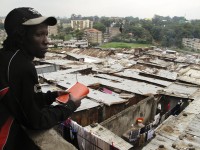Topics:
Slum Regularization
Slum Mapping
Location: Mathare, Nairobi, Kenya
Organizers:
The Spatial Collective
Shack/Slum Dwellers International
Background: The community of Mathare in Nairobi, Kenya, is not marked on any official map of the city. On Google Maps, its streets appear as blank spots near a hospital and a road. However, Mathare is a large, densely-packed slum, with narrow streets and hundreds of residents. Like many slums in the developing world, Mathare is invisible on maps because residents are illegal squatters without formal land tenure, despite de facto possession of the land: in some cases, such as in Mumbai’s Dharavi settlement, multiple generations have lived on the same plot without formal recognition of land ownership land. There are many causes of such persistent landlessness, including marginalization of slumdwellers from government institutions; inadequate capacity of the cadastre system to register new property owners; loss of property records due to recent conflict; competing property claims and interests; and entrenched political considerations. For many of these settlements, invisibility on a map is just one manifestation of their broader absence (whether intentional or structural) from the governance systems.
The precarious status of property ownership often contributes to continued poverty and public health problems, as residents lack the security to invest in housing upgrades and cannot post their property as collateral against loans; additionally, municipalities are reluctant to extend basic services such as clean water or garbage collection to properties with unresolved claims.
Program: As a first step towards overcoming land ownership barriers to development, residents of Mathare have joined with local and international NGOs to map their communities using Information and Communication Technologies (ICTs). Members of the Spatial Collective use GPS data, an online platform, and street-level photographs, to not just put streets on the map: they’re adding points-of-interest like schools, shops, and churches, as well as informal dumping grounds and broken infrastructure to give a detailed record of the community Mathare residents have built. Such documentation helps negotiate residents’ rights in discussions with local authorities.

A similar initiative by a member of Slum Dwellers International documents building footprints and public spaces (such as streets) in Mathare using regularly updated satellite images. In 2013, the map was used to assist the local utility run a communal water line into Mathare for the first time. At first residents were hesitant to move their homes in order to allow construction of the subterranean pipe: strong urbanization pressures mean there are no guarantees they could reclaim their plot when work finished. However the map acted as a precise community memory of their ownership, assuaging doubts and allowing construction to proceed, plot by plot. While not final solutions to the complex problems related to land tenure, such mapping initiatives enable residents to begin negotiating with municipal authorities by proving the existence and intricacies of their communities.
Transferability: Low-cost mapping techniques are increasingly being used around the world as a grassroots way of recording ownership, lobbying for services, and gaining political influence. The spread of information and communication technologies has enabled this work, especially due to the deep penetration of cellular networks in the developing world. The addition of cameras to cell phones is adding another layer to mapping, allowing on-the-ground photos to be synced with GPS coordinates. There are many examples of this work: for instance in 2012 a World Bank-sponsored project in the Dar Es Salaam, Tanzania neighborhood of Tandale earned international acclaim through a TED Talk (~10:00). For further information on mapping and more project examples, refer to the topic on the Shack/Slum Dwellers International site.

Sources: The case of Mathare was showcased on the Global Land Tool Network, and originally chronicled by National Public Radio. Warner, Gregory. “In Kenya, Using Tech To Put An ‘Invisible’ Slum On The Map.” National Public Radio. 17 July 2013. http://www.npr.org/blogs/parallels/2013/07/17/202656235/in-kenya-using-tech-to-put-an-invisible-slum-on-the-map
Images credit of NPR

